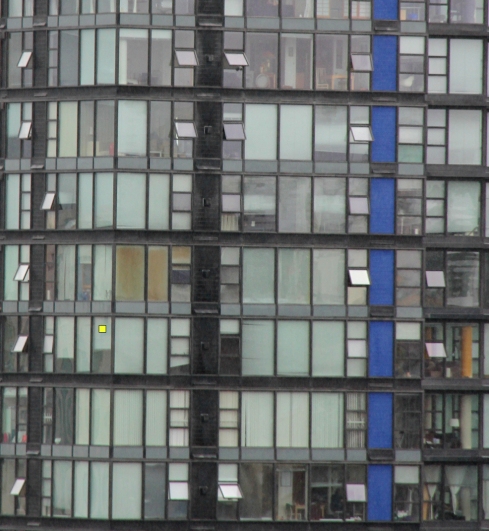The Process For Addressing Window Cleaning Complaints
Window cleaning. All buildings require it, it happens at least once per year, and the service gets done with everyone hoping for one thing: no complaints.
However, no matter who you hire or how they clean the windows, there are bound to be people who just aren’t happy with something. So it is in everyone’s best interest to work together to see what the issue is, solve it quickly, and leave everyone feeling good about the service.
Unfortunately, the biggest impediment is often getting the three parties involved to co-operate in the process to solve these problems smoothly and efficiently.
1) Clear communication about the problem between the resident, property manager, contractor.
2) Identifying the problem. The contractor must figure out where the issue is and what precisely is causing the complaint.
This involves either
A) See from inside the suite, or
B) identify through markers on the glass (Stickie notes, etc).
Ideally both A & B are involved.
3) Re-Clean the glazing, or report necessary fixes required to property manager to resolve the issue.
Part 1) Communication about the problem.
“Strata is not happy with the service.”
This is great to communicate that a problem exists, but not what the issue is. Why is the strata unhappy? Most times, I then receive more specific information. For example:
“Unit 709’s bedroom window is still dirty. It must have been missed.”
This is a large assumption.
Consider for a moment; what is this actually telling me? There is a resident who is unhappy with the clarity of their vision when looking through their bedroom window — and they live in unit 709.
This is enough to prompt the contractor to take action to resolve the issue, but leads us to our next and often biggest challenge – where is it?
Part 2) Find the problem.
Using the picture below as a reference, perhaps you can engage in an exercise we are often asked to undertake. In this example, where is unit 709, and where is their bedroom window?
What if their bedroom has several windows?

Better yet, what if we were asked to find a problem with unit 1503’s living room window? If we were told to count up from the ground, is there a 13th floor with the way the floors are numbered. Is the 1st floor on the ground floor, or the second? Each living room in this example seems to have several windows, and which pane or panes of glass have an issue?
Further to communicating that there is a problem, we now have to find the glazing with the reported issue from outside the building. There are no unit numbers outside, so unless there is some identifier we are dealing with a ‘best guess’ scenario. For this reason, we ask for 2 things: to meet with the resident to both identify the problem (more on that below), but also to figure out where on the building the issue is and what it looks like.
If someone cannot meet us to show us from inside their suite where this is, we ask that a stickie note or piece of paper be put up on the inside surface of the glass so we have a visual clue as to what to look for from outside.
A visual marker gives the contractor something to look for, allowing the worker to set up ropes or access to exactly the right spot, and address the pane of glass with the reported issue.
Now’s we’ve found the area with the issue.
Step 3) Re-clean the glazing, or report fixes necessary to the property manager.
If we have gotten to this step, we can clean the exterior surface of the glass again.
But what if the cause of the complaint isn’t actually related to window cleaning? What if this problem can’t be solved by cleaning the outside of the glass with soap and water?
Glass is glass. We look through it, usually not at it. If our focus moves from the view looking through it to looking at the glass, then there is a problem. People consider their view through their windows right after a window cleaning service is performed. If they look through clear glass with no impediments, they usually are happy. If something impairs their view, the usual instant response is: something’s wrong. Therefore the windows must not have been cleaned correctly. Therefore I must complain and get this corrected, it is the window cleaners fault.
In many cases, this assumption is correct. Mistakes can be made, windows can be missed during a cleaning service, and sometimes a window cleaner going back to fix this oversight or mistake is the quick and easy answer. The problem is, in many other cases, there is more to it than that.
This is where it gets challenging, and why the process must exist.
What is actually the problem? This is the primary reason we ask to see the issue from inside the suite. It allows us to speak with the resident, and to see the issue from their point of view.
Problems Encountered – New Windows
-scratches in the glass hidden under the dirt, revealed when windows are cleaned. Often from construction process.
-construction materials hidden under the dirt, revealed when cleaned: silicone, paint spatter, concrete spatter, glue from protective blue plastic, etc.
-bits of blue plastic still stuck to corners of windows not having been removed properly during the construction clean
Problems Encountered – Old Windows
-glass ‘running’ (with certain types of very old glass, vision will be distorted as it will eventually begin to flow downward. Granted, that could take 30-40 years, but it isn’t something that can be corrected with cleaning)
-broken window seals between panes of glass leading to: condensation between glass panes, mold between glass panes, dirt, etc.
-mineral deposit staining (minerals from concrete and other building structure leached out by rainwater, deposited upon glass, leaving a milky film that grows steadily more visible – unable to be removed without chemicals and razors).
-cracks, holes, bubbles: these have been found in old glazing, and cannot be removed with soap and water.
Misc. Common Issues – Not Valid
-dirt on the inside (look through the glass and the view still looks dirty after the service, often times the inside surface of the glass needs to be cleaned, often difficult to tell especially if the window is difficult to reach)
-not included in the agreed-upon scope of work (window is accessible to resident, and strata didn’t agree to pay to have those windows included in the scope)
-spider web nests in the corner of the windows. (spider web is still there, so my window must have been cleaned. Strange logic; especially when the glazing is clean. Spiders can rebuild their webs within 24 hrs.)
-a bird defecated on the window again (is there a nest on the building above this unit? Is there a bird defecating on it every other day? The contactor is only obligated to clean it once, they can’t come back once a week to address a recurring soiling issue as part of the scope)
Misc. Common Issues – Valid
-‘blips’ or squeegee marks: these can be hard to see when doing the job
-dirty water running down over the glass after service is complete
-window missed, still dirty on the outside.
To read about a nightmare window cleaning issue which caused me to change my approach to dealing with window cleaning complaints or deficiencies, you can click here to read that. I hope this helps demonstrate some of the challenges present in dealing with these issues as they arise for the contractor. There often isn’t one simple answer, and just going back and cleaning the glass again can lead to frustration on all sides if that doesn’t address the problem. So everyone understanding and engaging in the process – to get great results – benefits everyone, and should be encouraged by all.

